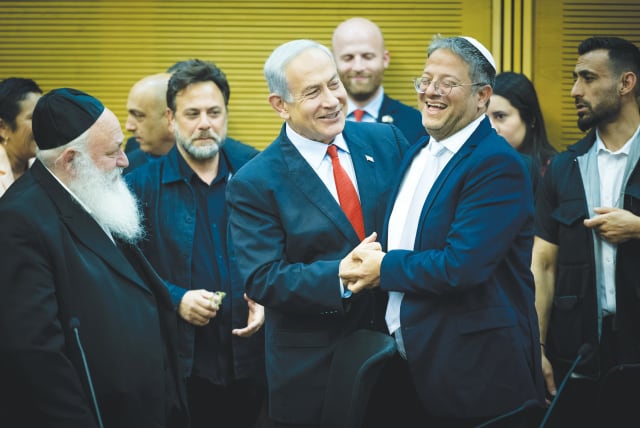Can Netanyahu reverse course and repair Israel's social fabric? - opinion

The wishful thinking of some analysts notwithstanding, this is not Israel’s “constitutional moment.” We are far from the broad national consensus needed.
What would happen if Prime Minister Benjamin Netanyahu, the heads of the main opposition parties – Benny Gantz and Yair Lapid – and the most vocal protest activists, suddenly decided to restore sanity, end the confrontation, and try to reach a compromise anchored in a unity government?
No problem, you might say – all they need to do is negotiate in good faith and hammer out the details. To use the language of conflict resolution and game theory, the bitter zero-sum conflict that appears to be headed towards a disastrous head-on collision would be transformed into a win-win arrangement. Israelis could then turn the intense energies devoted to cultural and political warfare towards dealing with other pressing challenges and opportunities.
Except that the reality is always far more complex than idealistic academic formulas. Locked in a “mutual hurting stalemate” in which neither side can impose its vision, even getting to the table for negotiations is extremely difficult. As demonstrated in the failed attempts under the auspices of President Isaac Herzog and the relentless news cycle, both sides are convinced of the absolute righteousness of their cause, and ascribe the worst intentions to their opponents.
In such conditions, reaching a compromise that does not appear to be capitulation is an extremely difficult challenge, as reflected in the many tragic failures to do so that tear societies apart. Even if the leaders of the tribes manage to agree on a roadmap, in which judicial reform is one of many contentious dimensions, those for whom disruption and chaos are ends in themselves, or paths to enhancing their own power, will try to sabotage any deal.
The wishful thinking of some analysts notwithstanding, this is not Israel’s “constitutional moment.” We are far from the broad national consensus needed for a constitution that would lay out the rules of the democratic game. On the contrary, anyone paying attention realizes that the different tribes live in alternate worlds, with competing values, perspectives, and priorities – and almost no understanding or common language.
Given this situation, what are the possible paths for repairing enough of the social fabric to allow us to live together and cooperate, and to allow the Zionist miracle to continue and thrive?
How can we save the Zionist miracle?
First, it is necessary to acknowledge that words alone have little impact – including Netanyahu’s recent pledges to seek consensus and heal wounds – and need to be accompanied by meaningful and widely visible actions. In the language of diplomacy, these substantive actions are known as confidence building measures (CBMs), such as in November 1977, when Egypt’s president Sadat flew to Israel to meet prime minister Begin, immediately reversing three decades of war and boycotts. Motta Gur, IDF chief of staff at the time, warned Begin that Sadat’s move was a ploy to assassinate the Israeli leadership gathered at the airport to greet him, while Arab leaders denounced Sadat and broke off diplomatic relations with Egypt. Simply by stepping off the plane and shaking hands with Moshe Dayan and Golda Meir, Sadat changed perceptions in Israel.
CBMs come in pairs in which the actions of one side are recognized and reciprocated by the other, moving slowly and step by step. A successful process builds towards a structure in which both sides have demonstrated recognition that returning to unrestrained confrontation would be too costly. Understanding this and throughout the peace negotiations, Begin provided his own visible gestures.
In the current political crisis, credible moves towards cooperation would have to overcome the deep skepticism created when Netanyahu blocked implementation of the April 2020 rotation agreement with Benny Gantz (following the third indeterminate election). Even if Netanyahu expressed regret and promised not to repeat this behavior, his words, on their own, would not be believed. Concrete measures that could not easily be reversed, and demonstrations of commitments to change, are necessary.
To cross this threshold, Netanyahu might replace one or two of the noisiest and most distrusted ministers and the likely spoilers from the coalition. This would involve a risk to his own position and expose him to criticism from his political allies, but taking risks reinforces the significance of the action. On the side of the opposition and protesters, taking clear action to prevent the practice of blocking main roads or of besieging Ben-Gurion Airport are comparable measures. This also involves risk, and such moves towards compromise would be denounced by the spoilers as “selling out the cause.”
To get the process moving, one or more public figures involved in the conflict will have to make the first move, signaling an intention to move away from the brink and towards restoring cooperation. The specifics are less important than getting this message across, while telling others what they should do instead of setting an example is counterproductive.
Finally, it is important to stay rooted within the limits of political reality at any given time. Until enough of a consensus is forged, talk of negotiations on an Israeli constitution, or even a unity government, is overreaching and likely to create more conflict. If Israelis from across the ideological spectrum can stop the momentum towards self-destruction, and start to recover the basic Zionist consensus, dayenu, for now.
The writer heads NGO Monitor and is emeritus professor at Bar-Ilan University, where he founded and led the Program on Conflict Management. His book Menachem Begin and the Israel-Egypt Peace Process: Between Ideology and Political Realism was published by Indiana University Press.
Jerusalem Post Store
`; document.getElementById("linkPremium").innerHTML = cont; var divWithLink = document.getElementById("premium-link"); if (divWithLink !== null && divWithLink !== 'undefined') { divWithLink.style.border = "solid 1px #cb0f3e"; divWithLink.style.textAlign = "center"; divWithLink.style.marginBottom = "15px"; divWithLink.style.marginTop = "15px"; divWithLink.style.width = "100%"; divWithLink.style.backgroundColor = "#122952"; divWithLink.style.color = "#ffffff"; divWithLink.style.lineHeight = "1.5"; } } (function (v, i) { });

